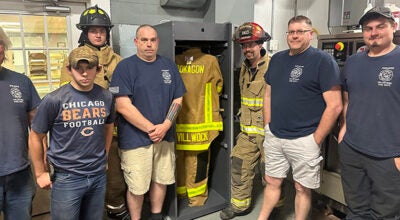‘Plume’s’ potential path put Borgess-Lee in lockdown
Published 9:00 am Friday, September 11, 2009

In addition to a decontamination room in the new emergency department, Borgess-Lee Memorial Hospital set up its decontamination tent outside the hospital. (Photo courtesy Borgess-Lee Memorial Hospital)
By JOHN EBY
Dowagiac Daily News
While it might seem like factory workers overcome by chlorine gas would test Borgess-Lee’s emergency room, a disaster such as Thursday’s simulated emergency response actually checks the entire hospital.
“We treated and decontaminated a total of eight mock patients” after the exercise got underway about 7:33 a.m., said Sandra Claborn, who directs the emergency room and surgery.
“It involved the entire hospital,” Claborn said. “Housekeeping helped put up the decontaminating tent. You need people to get you supplies. Communications – we used walkie talkies. Additional personnel. If I pulled a nurse from somewhere, maybe someone else would have to be brought in.”
All departments submit lists of staff on duty for assignment. Others could be called in.
For purposes of the drill, back-ups were phoned and queried about their availability.
“We also look for alternative places to see patients,” Claborn said. “We talked about using the recovery room when we were filling up down here.”
“You’ve got to keep ramping up, so to speak, when the scenario changes. You never know how far it’s going to go,” said Sue McCormick.
Claborn debriefed the Daily News along with McCormick, director of administrative services. In an emergency, McCormick becomes the hospital’s point person for dealing with the media.
Claborn said symptoms would include skin and eye irritation to chest pains and breathing difficulty. One patient arrived unconscious, according to the scenario.
Some received respiratory treatment, others X-rays and IV (intravenous) solutions.
One patient with chest pains was “admitted,” while the rest were discharged after treatment.
“There were participating Mennel Milling employees who were brought in as ‘patients,’ ” Claborn said.
McCormick said the drill warranted a code yellow “lockdown” of the hospital “because there was a possibility of the plume’s air direction coming this way. It protects all of the patients and visitors already here.”
In a real event, “Nobody in, nobody out,” with security posted at entry points.
“Also, a lockdown (insures) contaminated patients do not flow through our facility,” Claborn said. “We wanted to bring them into an area where we could triage them and then send them to a decontamination tent.”
The new multi-million-dollar emergency room is equipped with a decontamination room with a single shower. Patients are buzzed in directly from outside without traipsing through the ER itself. Personnel wear safety suits inside.
With a number of patients, the outdoor tent is preferred.
The decon tent was set up by 7:55.
Though simulated, an employee walking into work came into contact with a contaminated patient, so she was dispatched to the tent, too.
The hospital has its own internal incident command center.
If Claborn needed additional help for the ER, from doctors to nurses, she calls the incident commander, who can mobilize additional manpower in a matter of minutes.
As for what kind of forewarning the hospital had of the exercise, McCormick said drills are required twice a year. They do fire drills frequently.
“Some (key managers) knew there was a going to be a drill,” Claborn added, “but you want it to be simulated as close to real as possible.”
“We were lucky,” Claborn said, “that we happened not to have any real patients at that time.” Of course, “We would have let them in and seen them appropriately. We wanted to participate in the county drill. We want to do that and be a part of that. To me, it was a plus that we got to do it in the new ER because we had not used our decontamination room.”
“It was a great training exercise,” McCormick said.
The two women have just come from the hospital’s internal response review.
Later this month, they will meet with the exercise’s other participants for a wider critique.






